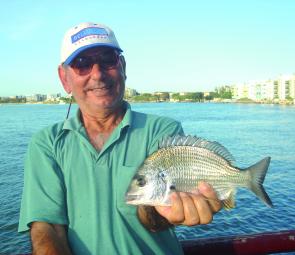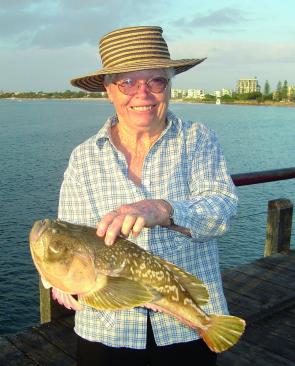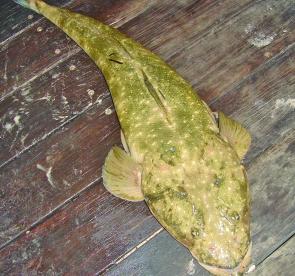Gee, the time goes fast! We are already in the middle of 2009, which for the first half was basically washed or blown out. Now that the winter months have set in we should see conditions improving, allowing trips outwide to tackle some big fish.
The last remnants of the heavy rains have gone and the estuaries are finally flowing with cleaner waters, allowing the bream to really come on the chew. When the mullet arrive it is normally when the bigger bream also come in, as they feed under the large masses of mullet taking the pickings afforded them.
The deeper areas of the Pumicestone Passage, such as the Blue Hole and the main channel along the Boardwalk have a stack of trevally and bream. These fish are very well feed and unless you have the freshest of bait or livies then you don’t stand much of a chance.
Lures like the Squidgey flick baits and River2Sea 120mm minnows are catching a few early in the morning. Deep Divers work well on the running tides as they can be held in position working against the current. This seems to allow the fish to attack as they pass when moving to another spot or catching bait. A few sharp raps now and then and other movements certainly increase your chances of nailing a big one.
Hardbody lure fishing with larger lures is fairly scarce around the Passage area, which makes sense if you think there is only bream, whiting and flathead to be caught. But believe me when I say you would be so surprised of what is in the Passage on any given day.
Now that the bream are on in numbers it would be wise to stock up on a few blades to work around the structures and pontoons within the canal systems. I find the Damiki Vaults and TT’s the best value for money, but if you want to step it up to the proven winners then Ecogear is a name that you should not forget. The SX40 hardbodied saltwater tournament series have been in my tackle box since they came into play and I can honestly say that they have taken quite a few fish.
The better fresh baits for the big bream are live herring or very fresh, yabbies and mullet strips. For those who target the whiting then yabbies and bloodworms are the answer to success but try the small poppers for something completely different. It is amazing how aggressive little whiting can be first thing in the morning when presented with a 50mm popper.
The Blue Hole has produced good catches of large whiting and bream with golden trevally to 3kg and some welcomed queenfish. Normally I would be working Military Jetty or the weir at the back of Pelican Waters for them just before dawn but they have ventured out past their normal haunts.
The trevally are once again chasing the hardiheads into big schools at low tide near Bill’s Boat Hire. The deep gutter that runs from Bill’s down to the sailing club is the spot to look for them. Tossing 20-30g metal slugs can work a treat in such heated times.
Bells Creek has become very shallow at the southern entrance as the sand shifted when the big rains and floods came through, so take care. Work your way down before Coochin Creek, fishing just on off the channel in the shallows and cast your bait into the deeper waters for whiting.
A strong berley trail is the recipe for success even when fishing for whiting. Be sure not to use full chook pellets because they will fill the fish. Put them in a bucket with a bit of water and sand allowing them to break down to a powder before using. A 1kg bag should last you about three hours provided you don’t go overboard with it. Of course you can always throw in a heap of leftovers like prawn shells, crab pieces and old bait provided they are crushed up very well.
The flathead are a little slow but that is to be expected at this time of year. I find that anything pumpkinseed or pink in soft plastics are just killers on the flathead around the Sunshine Coast so give them a go. If you can get you hand on them then try live poddy mullet because big flathead just cannot resist them.
The beaches took a tremendous pounding over the past few months but they have settled to form some nice holes that can be seen at low tide. There are not too many official gutters around but as you work your way up to Point Cartwright close to access 36 and beyond, there are parts forming.
The low tide offers the best opportunities to tackle dart, whiting, bream and tailor. Access 39 on the Wurtulla strip is one location to try and if you are lucky enough to get a high or low tide on dusk then get down there. The baits of choice are strips of pilchards on a #4 to 1/0 long shank hook and tied off with a double hitch to protect the bait further.
If you are targeting tailor then you will probably have a whole pilchard on a set of 3/0-5/0 gangs depending on the size of your baits. Experience has taught me that using a paternoster style rig in the surf with two hooks and alternate baits gives you a far better chance of landing everything from bream to tailor. The gangs just don’t cut it at this end of the coast.
Fishing Kings Beach at dusk can reward you with whiting and an occasional sweetlip. Moffat is another good choice for evening fishing for tarwhine, bream and again sweetlip.
The Barwon Banks is again on the map with some great catches of morwong, parrot, trag, hussar, snapper, sweetlip, red throats and pearlies all being listing as heavy on the bait. The mids are fishing well in the morning and the best plan is to head wider after 9am to around the 85m mark.
The deeper water is the spot to go for trag and the pearlies, with big snapper always a welcome sight. It is not necessary to travel all the way to the bottom of the Hards, which is a trip of around 55km each way, the fishing on the closer systems has proven to be just as bountiful.
The rocks that are positioned on the southern end of the Banks is an area covered in rough rocky country and produces parrot, snapper, hussar, reds and a variety of other reefies. I can still remember my best session at this spot when we bagged out on snapper in 23 minutes after travelling just under an hour to get there. Sensibly we turned around and came home after an hour knowing that nothing was going to top that.
If you head due east from the rocks you will notice that the bottom drops away about 10m at a time. This is called the steps and each drop-off is certainly holding fish so it is worth exploring the ridgelines.
Wide Caloundra is a favourite at winter, and so too is the Dog Leg that is situated about 8-12km north off the tip of Moreton Island. This is a relatively sandy area but holds nice numbers of snapper on a good day. It is also a good cobia spot in the later half of the year. You can fish from 60m right out to beyond the 120m line where the Kosi sits, although there is not much left now.
The Kosi is an old ship wreck that is easily spotted on your sounder showing wire weed in abundance, but like all good spots it has been over-fished for some time.
Caloundra 5 and 7 mile reefs come alive in winter with snapper and red emperor the target species on an evening fish. Like Murphys there is a lot of undulating country down below providing heaps of hidey-holes for fish. Coral trout are another fish that frequent this area in good times but mostly the sweetlip will keep you busy.
Murphys, which is situated east south east from Point Cartwright is a favourite amongst boaties, as is the areas around the Gneering Shoals. The popularity for these spots is due to their close proximity to Mooloolaba Harbour. At worst is would take you 15-20 minutes to get to the outer edge of these spots and they have a large variety of species available to us.
Soft plastics in 5” and 7” work wonders around the area, and it has been known to be a testing ground for new colours in the past. Floating a live or fresh dead bait out the back is nearly mandatory as big amberjack and cobia work the bait schools below. Have a rig on the surface in mid water and on the bottom out so that you cover the majority of the water. Plenty of berley is again the order of the day and best baits include squid, pilchards, tuna strips, yakkas and slimies.
The snapper have been showing their hand since early May so as we head in to the depths of winter lets hope that the strong run continues. Have Fun!
Reads: 7576
Bream are still around the Boardwalk in Caloundra.

A stargazer taken from the Pumicestone Passage.

Flathead fishing may be slowing down but the fish are still there to be caught.




